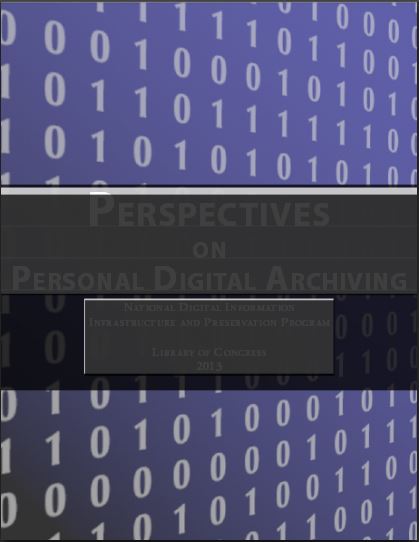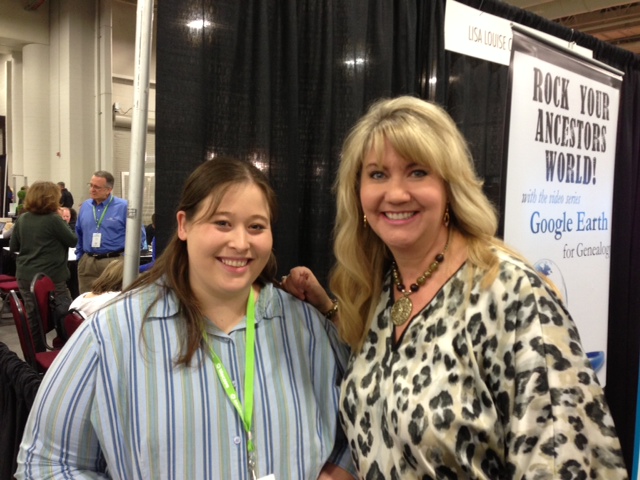Take a Break: A Video Guaranteed to Take You Back to a Gentler Time
Grab a pop, find a porch swing and enjoy Pickin’ and Trimmin’
Grab a pop, find a porch swing and enjoy Pickin’ and Trimmin’
Digital archiving is a hot topic for genealogists these days. Digitizing our family documents, photographs and other artifacts is one more way to help us preserve and share our heritage. Well, the Library of Congress wants to help us out! It has published a free e-book, Perspectives on Personal Digital Archiving.
 Scroll through the table of contents and you’ll see immediately why this book is valuable to family historians. There are lots of how-tos on preserving photos and other images: what file formats to use, cloud storage, adding digital captions, image resolution and more. There are sections on how everyday people are preserving their own digital archives. There’s even a great chapter on making sure your digital files live on after you pass away.
Scroll through the table of contents and you’ll see immediately why this book is valuable to family historians. There are lots of how-tos on preserving photos and other images: what file formats to use, cloud storage, adding digital captions, image resolution and more. There are sections on how everyday people are preserving their own digital archives. There’s even a great chapter on making sure your digital files live on after you pass away.
There’s an entire chapter on digitizing for the family historian. It gets to the heart of a genealogist’s file organization and storage needs: “Digital genealogy could result in a heap of text files (such as GEDCom files), image scans (most sites enable you to save an image in either JPEG, TIFF or PDF formats), audio files and video files. It’s best to follow the Library of Congress’s personal archiving advice, which is basically to:
1) organize everything within one collection folder
2) backup your collection onto several storage media in several different places
3) migrate your collection every five years or so to new storage media.
Don’t trust that a third-party genealogy service will always remain in business and keep your stuff safe forever. You should have your own copy handy and another copy backed up somewhere else.”
Great advice! Check out the entire book for yourself. And thanks to GenealogyBlog authors Leland and Patty Meitzler who blogged about this new e-book on their site.
“One of the most incredible and likely true stories I’ve ever seen!” announced Dave Obee as he met with Genealogy Gems Listener Sarah Stout, the winner of our #RootsTech 2013 conference registration contest.
The question to contestant was “who’s class would you most like to attend at RootsTech?” Sarah’s answer was Dave Obee, and that was because she was  running up against a Canadian brick wall in her family history research, and Dave is a Canadian Research Guru!
running up against a Canadian brick wall in her family history research, and Dave is a Canadian Research Guru!
Read more about Sarah’s incredible genealogical brick wall:
In my new video at the Genealogy Gems YouTube channel I get the two together and Dave dishes up 10 terrific tips that will not only help Sarah, but are sure to prove their worth in your own family tree climbing.
Dave Obee’s Top 10 Tips:
1. Create a Timeline – “plot her life…it’s easier to see the holes.”
2. Understand Geography – “plot movements”
3. Find Every Possible Record
4. Understand How Records Were Created
5. Read Every Local Story in Newspapers at that Time
6. Tap into Local Knowledge – “Locals know more” (historical and genealogical societies)
7. Go There if You Can in Person
8. Look for Negative Proof
9. Collaborate with Other Researchers
10. Be Diligent About Proof
Resources Mentioned in the video:
Subscribe to the Genealogy Gems YouTube Channel for free to receive instant updates of all of my latest videos from RootsTech 2013 and beyond.
Many of us know the fabulous Chronicling America newspaper site. Hosted by the Library of Congress, it catalogs all known U.S. newspapers and provides free access to more than six million digital newspaper pages. Well, this site keeps getting better. Content continues to grow and expand into other languages. And–something I personally love–the site will be easier to use on my iPad and iPhone!
First, let’s look at growing content: 130 new titles and 800,000 pages are new on the site. New titles include French and Spanish newspapers, like the French-English bilingual paper shown here.
Historical newspapers give readers a front-page view of American history. Recent additions to the collection echo popular feelings about presidential politics, slavery and westward expansion. We as genealogists can read as it were over our ancestors’ shoulders. Even if we don’t find them mentioned there specifically, we can learn a lot about their lives from newspapers of their day.
As I mentioned, Chronicling America now works better on mobile web devices. Specifically mentioned in a recent press release are “the ability to enlarge a portion of a newspaper page in a tablet or mobile phone device by using a pinch-to-zoom gesture. Also, a thumbnail navigator that appears on every page facilitates panning and zooming the image.” That’s a big improvement for users who have been frustrated at trying to use the site on the small screen!
Want to learn more about newspaper research for family historians–especially how to find newspapers online? Check out my book, How to Find Your Family History in Newspapers, available in paperback and as an e-book.